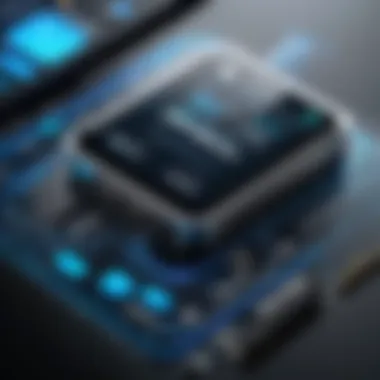Exploring the Impact of SD Express Technology


Intro
In the world of digital storage, technologies have evolved at a breakneck speed, adapting to the increasing demands for quick data access and efficiency. The SD Express technology stands out as a pivotal advancement, incorporating both PCIe and NVMe protocols, bewitching tech aficionados and IT professionals alike. This technology marks a quantum leap beyond conventional SD card functionalities and redefines how we comprehend storage solutions.
Within this piece, we delve into the nitty-gritty of SD Express, breaking down the intricate specifications that underpin its design, unveiling performance metrics that set it apart from predecessors, and casting a discerning eye on its applications and future potential. Emphasizing what makes this technology tick is essential for anyone invested in the nuances of information technology.
In a landscape where speed and efficiency are non-negotiable, understanding the implications of SD Express is not just beneficial—it's indispensable for professionals tasked with ensuring that technologies meet ever-evolving needs. As we round the corners of this discussion, prepare for a detailed exploration of what SD Express means for our digital future.
Preamble to SD Express
In an age where data capacity and speed are constantly under the microscope, SD Express technology emerges as a pivotal development, altering our understanding of memory storage. This section lays the groundwork for comprehending why SD Express is crucial in today’s tech landscape. It is not just about having more storage; it's about making that storage work smarter and faster.
SD Express combines the legacy of traditional SD card technology with cutting-edge protocols like PCIe and NVMe, creating a bridge between past capabilities and future needs. With applications ranging from mobile devices to high-end cameras, the implications of this technology are significant and multifaceted.
Historical Context
To grasp the importance of SD Express, one must first step back and consider the historical journey of Secure Digital (SD) cards. Established in 1999, original SD cards made waves with their ability to offer portable, removable storage. Over the years, SD technology has seen several upgrades—SDHC and SDXC being notable milestones that expanded storage capacity and enhanced formatting.
Each evolution of SD cards catered to growing demands for higher data rates and larger capacities, paving the way for a paradigm shift in storage technology. As devices began to churn out high-definition video and perform data-heavy tasks, the limitations of traditional SD standards became glaringly apparent. This backdrop paints a vivid picture of the necessity for SD Express.
What is SD Express?
SD Express marks a new chapter in the story of SD cards. Simply put, it enhances the original framework of SD by incorporating the PCIe interface and NVMe protocol. This fusion allows SD Express cards to offer data transfer speeds that can reach up to 980 MB/s—far surpassing what traditional SD cards can represent. The increased bandwidth is a game changer, especially for industries reliant on rapid and large data processing.
In practical terms, SD Express is a type of SD memory card that can communicate over the same physical interface as PCI Express, allowing devices to take advantage of high-speed data pathways. This means devices utilizing SD Express technology can handle more data in less time, boosting overall performance.
"As tech evolves, so must our tools; SD Express is that necessary evolution in portable storage technology."
In summary, understanding SD Express is about recognizing both its roots in traditional SD technology and its potential to redefine how we handle data in various applications. From photography to mobile computing, the impact of SD Express is set to resonate through the tech landscape for years to come.
Technical Overview
Understanding the technical aspects of SD Express is pivotal for anyone diving into this revolutionary technology. A grasp of its specifications, integrations, and innovative protocols can help illuminate the direction tech is headed and the implications for everyday devices. This section acts as a foundational pillar, unpacking how SD Express stands distinct from traditional SD card technologies.
Specifications of SD Express
SD Express cards represent a significant leap in both capability and efficiency compared to their predecessors. They integrate PCIe and NVMe protocols, enabling faster data transmission rates often exceeding 985 MB/s. This step-up is crucial for applications demanding high bandwidth, particularly those involving 4K/8K video recording and high-resolution imaging.
- Form Factors: SD Express supports various form factors, ensuring compatibility with a wide range of devices. The microSD and standard SD formats are often utilized in consumer electronics, catering to different needs.
- Capacity: With capacities likely reaching up to 1TB and beyond, SD Express embraces the data-heavy demands of modern applications.
- Speed Classes: Speed classes for SD Express have improved, featuring UHS-II and UHS-III ratings, which provide assurance of sustained performance during intensive write processes.
Integration with PCIe
Integrating PCIe with SD Express technology fundamentally enhances its performance metrics. In doing so, data transfer becomes more efficient, crucial for keeping pace with the growing storage demands found in today's digital ecosystem.
Structure of PCIe
The structure of PCIe constitutes point-to-point connections, allowing for multiple lanes to be used simultaneously. This characteristic is vital as it contributes to an increase in the data transfer rate while minimizing latency. Each lane can handle a data rate of 1 GB/s, which when multiplied significantly bolsters overall performance. Furthermore, the architecture supports scalability, making it a beneficial choice as technology evolves.


"PCIe’s robust framework and high bandwidth are why it’s considered the backbone of data-centric applications today."
Another unique aspect is the full duplex capability, allowing simultaneous transmission and reception of data. This results in a more fluid performance experience, especially for real-time data processing tasks.
Benefits of PCIe integration
The integration of PCIe within SD Express directly translates to numerous benefits. One standout characteristic is the improved bandwidth availability, making it a compelling choice for professionals who rely heavily on speed and efficiency.
- Enhanced Data Throughput: PCIe's architecture significantly enhances data throughput, crucial for operations involving large file transfers.
- Backward Compatibility: This integration does not sacrifice compatibility, ensuring older devices can still leverage the enhanced speeds through transitional frameworks.
- Scalability: With standards evolving, PCIe’s structure can adapt, hence providing longevity to the technology employed.
Intro to NVMe
NVMe is another critical player in the evolution of SD Express. Standing for Non-Volatile Memory Express, it represents a protocol designed for interfacing with SSDs, capitalizing on the speed of flash memory and the architecture's ability to manage large data workloads effectively.
Key features of NVMe
The essence of NVMe lies in its unique ability to reduce latency and increase input/output operations per second (IOPS). This contributes to faster data access, which can be an absolute game-changer for many applications.
- Parallel Processing: NVMe supports hundreds of parallel queues which sharply contrasts traditional protocols that are limited.
- Low Power Consumption: Designed to be power-efficient, NVMe enables extended battery life in mobile devices while maintaining high performance.
- Efficiency in Task Handling: The technology allows for more robust handling of tasks without burdening the processor, leading to a smoother operation overall.
Compatibility with existing SD standards
NVMe's compatibility with existing SD standards ensures that we do not merely abandon legacy systems but instead provide a bridge to modern technological enhancements. This aspect means that users can gradually adapt to newer technologies without the need to replace entire systems.
- Interoperability: Many devices can utilize SD Express without needing a complete overhaul of their architecture, a desirable trait in fast-changing tech environments.
- Investment Security: It reassures consumers that their existing investments retain value, which is particularly important in sectors like photography and data storage.
- Flexibility: This compatibility offers not just security but also flexibility, allowing consumers to choose their upgrades in a more measured way, blending the old with the new.
Performance Enhancements
When discussing SD Express technology, understanding the performance enhancements it offers is crucial. This next generation of SD cards doesn’t just tweak existing specs; it introduces new possibilities entirely. The integration of PCIe and NVMe boosts the speed and efficiency of data transfer, which is essential for users requiring high performance in consumer electronics and professional environments.
Data Transfer Speeds
Comparative analysis with standard SD cards
In this comparison, standard SD cards show their age, particularly when looking at speed. Traditional SD cards have continuously peaked at approx 300 MB/s for SD UHS-III, whereas SD Express taps into the PCIe and NVMe technologies, potentially soaring to several gigabytes per second. The key characteristic here is speed scalability.
The unique feature of SD Express is its engineering that allows for multiple lanes of data transfer. It essentially bulldozes through the bottlenecks that exist in older models, pumping more data simultaneously. This is exciting, especially for applications involving video recording and high-resolution images. Plus, SD Express cards are inherently backward compatible with older devices, which eases the transition without throwing a wrench in the works.
Implications for high-resolution content
What does this mean for high-resolution content? Huge ramifications. Think about the 4K and 8K video files that are becoming increasingly standard. The demands of this high-quality media require data transfer rates that traditional SD cards can’t handle.
The primary contribution here isn’t merely about having faster cards; it’s about enabling creators and professionals to manage heavy files efficiently. The advantage is clear—less waiting and more productivity. However, a consideration to keep in mind is that not all devices can take full advantage of these upgraded speeds, leaving some users still in the dust, potentially.
Latency Reduction
Understanding read and write latency


Next up is latency reduction, a game-changing facet of SD Express technology. Latency is the delay between requesting a read or write operation and the actual execution. For many applications, seconds matter, and reducing this time translates into better user experience.
This technology employs NVMe's structures, designed to minimize bottlenecks and improve response times. This is a crucial choice for applications where timing and quick access are elements that can’t be overlooked. The capabilities inherent in SD Express mean much snappier responses, but it can push devices to their limits if not properly designed to handle these advances.
Effects on application performance
Now, let’s connect the dots to application performance. An immediate result of reduced latency means applications can pull and push data at faster rates. For certain fields like gaming, video editing, or scientific simulations, the effects are pronounced. Tasks that once took time to load or save can now be almost instantaneous. It’s all about enhancing workflow and ensuring efficiency.
However, the increased performance might bring forth the challenge of more demanding power consumption, steering users to consider their systems' capabilities. In sum, performance enhancing capabilities of SD Express create a compelling case for its adoption, revolutionizing how data is processed and managed.
Applications of SD Express
Understanding the applications of SD Express technology is crucial, as it showcases real-world implications and the potential transformative power this technology holds. SD Express is more than just an upgrade from previous standards; it opens the door to higher speeds, better efficiencies, and a diverse array of use cases. From everyday consumer gadgets to complex professional environments, SD Express makes significant contributions that enhance functionality and performance.
In Consumer Electronics
Cameras and recording devices
When it comes to cameras and recording devices, the shift to SD Express technology has been rather profound. With the demand for 4K and even 8K video recording rising, traditional SD cards often fell short. SD Express provides faster data transfer speeds, with potential rates reaching up to 4GB/s. This capability allows photographers and videographers to capture high-resolution content seamlessly, avoiding bottlenecks during intensive sessions.
One noticeable characteristic of these advanced recording devices is their ability to handle larger file sizes without a hitch. Quite simply, reduced lag is a game changer, helping users to record continuously without interruptions. A unique feature of some SD Express enabled cameras is their dual-interface support. This enables the use of both legacy SD cards alongside the more advanced SD Express, allowing flexibility in choice based on specific needs.
However, these enhancements come with their set of challenges. The common downside is the higher cost associated with SD Express cards, which can hinder accessibility for some users.
Smartphones and tablets
Similarly, SD Express technology paves a new path in the realm of smartphones and tablets. As devices become more integral to both personal and professional life, the need for speedier data transfer and robust storage has become critical. SD Express allows users to enhance device performance significantly, particularly for high-speed photography, gaming, and handling large datasets.
The ability to access apps rapidly and store more content without slowing down the system is a hallmark of smartphones and tablets utilizing SD Express. A pivotal aspect is that it lets devices operate at faster speeds, loading data swiftly, which enhances user experiences.
However, one noteworthy drawback is backward compatibility. Older devices may not support these advanced cards, requiring users to invest in newer technology, which might not be economically viable for everyone.
In Professional Settings
Use in data-heavy industries
Within data-heavy industries, SD Express technology brings a wealth of advantages that can transform workflows. Industries that require extensive data processing, such as media, gaming, and broadcasting, benefit enormously from SD Express capabilities. The rapid transfer speeds allow for faster content uploads and real-time editing, critically valuable when deadlines loom large.
A key characteristic of using SD Express in this context is its support for very high-capacity cards, making it easier to manage and store large datasets. This is particularly beneficial in situations like live broadcasts or large media productions, where every second counts.
However, the challenge arises due to the integration costs associated with new technology. Companies need to allocate budgets not only for the cards but also for equipment upgrades to support the enhanced standards.
Applications in scientific research
In the realm of scientific research, SD Express technology has started making strides as well. For researchers who rely on experimental data collection, speedy and reliable storage can significantly bolster productivity. Projects requiring large file sizes, such as genomic sequencing or large-scale meteorological data collection, can rely on SD Express cards to streamline their data acquisition process.
One apparent advantage of SD Express is its capacity for high data integrity; this is essential when working with data that must be preserved accurately for analysis or reproduction. Moreover, some advanced cards even include security features, safeguarding sensitive information crucial to research labs and institutions.


Nonetheless, like in other sectors, the compatibility issue with established systems might prove to be a hurdle. Researchers may find themselves needing to adapt their existing infrastructure to fully utilize these new advancements.
In sum, while SD Express technology presents a dynamic suite of benefits for both consumer and professional applications, the implications of its use entail a balancing act between embracing new technologies and understanding their constraints.
Future Perspectives
The world of storage technology is always on a fast lane, and SD Express technology is no exception. Its future holds a wealth of possibilities that intersect various trends, challenges, and projected growth areas. Understanding these future perspectives is crucial for IT professionals and tech enthusiasts, as they enable us to anticipate the evolving landscape of storage solutions.
Emerging Trends
Continued evolution of SD standards
As technology marches forward, so do the standards that underpin it. The evolution of SD standards is a testament to the relentless pace of innovation. New iterations of SD technology not only improve data transfer speeds but also focus on compatibility and efficiency. The recent moves towards adopting faster data interfaces and capacities have made it a vital choice for all kinds of devices, from gaming consoles to portable cameras.
One key characteristic here is the growing demand for higher-capacity cards. To meet these needs, manufacturers are now designing SD cards that can handle enormous amounts of data while maintaining swift read and write speeds. This continued evolution promotes versatility in applications—opening up pathways for enhanced performance and user satisfaction. Moreover, the unique feature of improved speed ensures that creators dealing with high-resolution video or professional photography reap notable benefits, drastically cutting down waiting time.
Potential challenges in implementation
With great advancements come significant hurdles. Potential challenges in implementation largely revolve around the adaptation of existing infrastructure. Many devices currently in use may not support the new standard without modifications or upgrades. This could lead to fragmentation in the market, where older devices struggle to keep pace with new technology developments.
A central characteristic of this challenge is the notion of backward compatibility. While it's highly desirable for new technology to be functional with older devices, it can also pose issues in ensuring reliability and performance. The unique feature of an uneven upgrade path impacts manufacturers' and consumers' adoption rate, creating a barrier that slows down widespread integration. Therefore, sticking points might arise when trying to balance cutting-edge technology with the practicalities of existing hardware.
Projected Market Growth
Consumer demand forecasts
When considering the consumer demand forecasts, we see an optimistic outlook for SD Express technology. As more devices become reliant on high-speed data transfer, the demand is expected to rise dynamically. Consumers are increasingly favoring faster and more efficient storage solutions, primarily due to the continuous push for digital media and cloud computing.
A notable characteristic of this growth is that it reflects shifting consumer behavior. The surge in video content creation, gaming, and the Internet of Things (IoT) application adoption work together to spur interest in SD Express. The unique feature of consumers wanting ever-more powerful devices multiplies its significance in the market, encouraging manufacturers to innovate continually. Thus, while competition may strain profits, it also fuels a cycle of advancement beneficial to the end-user.
Industry adaptations
Industry adaptations stand as a pivotal aspect of how storage technologies evolve. Industries are beginning to incorporate SD Express technology into their workflows more rapidly than before. For instance, sectors like photography and data-intensive applications are adjusting their infrastructure to leverage the advantages that come along with the new standards.
A critical characteristic of these adaptations is the emphasis on speed and reliability. High-performance tasks, such as video editing or data analysis, require swift data handling. The unique feature of integrating advanced specifications into everyday operations allows organizations to efficiently manage larger datasets. This shift not only enhances productivity but also positions companies favorably within their markets.
Such transformations come with their share of trials and benefits, yet the potential for enormous productivity gains makes embracing these changes a worthwhile investment for many in the industry.
The End
In summing up our exploration of SD Express technology, several vital points emerge, illustrating the significance of this advancement in data storage and transfer. First and foremost, the incorporation of PCIe and NVMe protocols fundamentally transforms how we approach data speed and efficiency in various devices. As we stand on the precipice of a data-driven age, this progression isn't merely a luxury; it's become a necessity in both consumer and professional domains.
Summary of Key Insights
The journey through SD Express has unveiled a multitude of insights that inform us of its burgeoning importance. Key takeaways include:
- Enhanced Data Transfer Speeds: SD Express supports speeds that can ascend beyond the limits set by traditional SD cards. This is called for not just by gaming and entertainment but also in industries demanding swift data transfer like healthcare and scientific research.
- Compatibility and Evolution: With its backward compatibility with existing SD standards, users can easily integrate SD Express cards into their setups without needing to overhaul their devices entirely. This adaptability presents a smoother transition for those looking to upgrade.
- Broadened Applications: From photography to mobile devices and even high-capacity professional applications, the implications of SD Express technology are vast. It's a game-changer for anyone working with high-resolution images or complex data sets.
Final Thoughts on SD Express
In closing, it’s clear that SD Express is setting the stage for the future of storage solutions. As technology continues to evolve, it’s essential for professionals and enthusiasts alike to stay informed about innovations like these. The advantages provided by higher speeds and reduced latency cannot be overstated. They are crucial for optimizing performance in an increasingly fast-paced digital world.
Embracing SD Express technology, therefore, is not just about keeping up with trends; it’s about leveraging the capabilities that the modern landscape offers. The importance of understanding and adopting this technology can’t get stressed enough, as it may very well dictate the standards of excellence in data handling tomorrow.
"Progress is impossible without change, and those who cannot change their minds cannot change anything."



